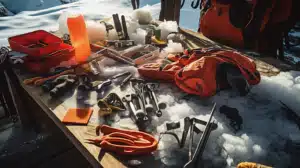Table of Contents
ToggleUnderstanding Trad Climbing Cams
As a rock climber, one of my favorite pieces of gear to discuss and use are trad climbing cams. These are mechanical devices crucial to the safety and success of traditional routes, providing anchor points in the rock to protect climbers from falls. Also known as spring-loaded camming devices (SLCDs) or simply camming devices, trad climbing cams are an important part of any trad climbing gear set.
Basics of Trad Climbing Cams
So how do trad climbing cams work? Well, they are placed into cracks in the rock and then expanded to create a secure placement. The cams can provide both passive and active protection, making them an essential tool for traditional climbers. The lobes of trad climbing cams are designed to expand and grip the rock, providing secure placements. They can be placed in various types of cracks, including parallel, flaring, and irregular cracks.
Trad climbing cams come in different sizes, typically denoted by color-coded bands. The sizes range from small micro cams (yellow or purple) to large cams (blue or green). The proper placement of these cams requires skill and experience, as climbers need to identify suitable cracks and determine the size of the cam that will fit securely in the crack.
Types of Trad Climbing Cams
When it comes to the types of trad climbing cams, there are three main categories I like to focus on: camming, spring-loaded, and hybrid cams.
-
Camming devices: These are the most common types of trad climbing cams. They use a lever system to expand and contract the lobes, allowing you to fit the cam into a wide range of crack sizes.
-
Spring-loaded devices: These cams use a spring mechanism to keep the lobes in place when the cam is not under load. They are more responsive and hold better in softer rock types.
-
Hybrid cams: These devices combine the features of camming and spring-loaded devices. They offer the versatility and wide range of placement options of camming devices with the holding power and responsiveness of spring-loaded devices.
Each type of cam has its own strengths and weaknesses, and the choice often comes down to personal preference and the specific demands of the climb. As you gain more experience with trad climbing techniques, you’ll get a better sense of which type of cam works best for you.
Remember, while trad climbing cams are a crucial part of your gear, they are not the only tools at your disposal. Other important pieces of equipment include trad climbing nuts, slings, carabiners, and of course, your trusty trad climbing helmet.
Selecting the Right Cam
Choosing the right trad climbing cam can make a significant difference in your climbing experience. Factors like cam size and brand reputation play a crucial role in this selection. Let’s delve deeper into understanding cam sizes and some of the best trad climbing cams available in the market.
Understanding Cam Sizes
Trad climbing cams come in a range of sizes, from tiny microcams that fit in very narrow cracks to larger cams for bigger cracks. It’s important to have a variety of sizes to fit different types of cracks.
Cams are typically denoted by color-coded bands, making it easy to identify the size at a glance. The sizes range from small micro cams (yellow or purple) to large cams (blue or green).
The size range for trad climbing cams typically starts at 0.1 inches and goes up to around 6 inches.
| Cam Size | Color Code |
|---|---|
| Micro Cam | Yellow or Purple |
| Small Cam | Red or Orange |
| Medium Cam | Silver or Gold |
| Large Cam | Blue or Green |
Best Trad Climbing Cams
When it comes to selecting the best trad climbing cams, there are a few models that stand out due to their performance, durability, and versatility.
-
Black Diamond Camalot C4: Known for its durability and wide range of sizes, making it a versatile choice for trad climbers.
-
Metolius Ultralight Master Cam: One of the lightest trad climbing cams available, which can be advantageous for long routes.
-
DMM Dragon Cam: Offers a unique twin axle design that provides a high degree of stability and placement options.
Remember, the best trad climbing cam for you will depend on your specific needs, including the type of rock you’re climbing, the sizes of the cracks you’ll encounter, and your personal preferences. To explore more about trad climbing equipment, check out our trad climbing gear guide.
In the end, no matter which cam you choose, remember that safety is paramount. Always double-check your gear placements and never climb beyond your limit without adequate protection. For tips on how to safely place and use your cams, refer to our sections on proper placement techniques and evaluating cam placement. Happy climbing!
Essential Cam Features
When it comes to trad climbing cams, there are a few features that really make a difference in their performance. Let’s dive into some of the key elements you should be familiar with: cam lobes and the camming angle.
Understanding Cam Lobes
Cam lobes are the heart of a trad climbing cam. They are the curved metal lobes that expand and contract to fit within the rock crack. The number of lobes can vary depending on the cam design, with three and four-lobed cams being the most common.
The lobes of trad climbing cams are designed to expand and grip the rock, providing secure placements. They can be placed in various types of cracks, including parallel, flaring, and irregular cracks.
Trad climbing cams consist of three main components: the cam lobes, the cam stem, and the cam trigger. Each component serves a specific purpose in the functionality of the camming device, allowing climbers to customize the placement and removal of the cams.
A key feature of trad climbing cams is their ability to expand and contract. When a climber places a cam into a crack, they can manipulate the trigger to make the cam lobes expand, creating a secure anchor. Conversely, when the cam is removed, the lobes contract, allowing for easy removal from the crack.
The Importance of Camming Angle
The camming angle is another crucial feature of trad climbing cams. It refers to the angle at which the lobes are set when the cam is in its contracted (or “cammed”) state. The camming angle can significantly impact the holding power and range of the cam. A smaller camming angle generally provides better holding power but a smaller range, while a larger camming angle provides a greater range but less holding power.
Understanding the camming angle and how it affects the performance of a cam can help you make more informed decisions when selecting and using trad climbing cams. Remember, the ultimate goal is to achieve secure and reliable placements to keep you safe while climbing.
Next, we’ll explore the techniques for placing and evaluating cam placements in our section on placing and using cams. But before that, make sure to check out our comprehensive guides on trad climbing gear and trad climbing techniques for more handy tips and advice.
Placing and Using Cams
It’s crucial to understand how trad climbing cams work and how to properly place them to ensure safety while climbing. Whether you’re a beginner or an experienced climber, these tips will help you effectively use your trad climbing cams.
Proper Placement Techniques
Trad climbing cams are one of the most important pieces of gear for traditional climbers, as they provide secure protection in cracks and other natural features on the rock. These cams come in various sizes, often labeled with a range, such as 0.5-2, indicating the range of crack sizes they can fit into.
Placement of these cams require skill and experience. As a climber, you need to identify suitable cracks and determine the size of the cam that will fit securely in the crack. Make sure to place the cam deep enough into the crack to ensure it can’t be dislodged by movements of the rope or by a fall. If you’re new to trad climbing, check out our article on trad climbing for beginners for more helpful tips.
Evaluating Cam Placement
Once you’ve placed your cam, it’s important to evaluate its placement. The cam should be placed in solid and stable rock features to ensure their effectiveness and safety. Carefully evaluate the rock and make sure the cam is properly seated and loaded in the crack.
To evaluate your placement, give the stem of the cam a gentle tug to ensure it’s secure. Make sure the cam lobes are evenly retracted and that the cam is not over-cammed or under-cammed. The sling or attachment point should be in line with the direction of pull in case of a fall.
It’s also crucial to regularly inspect cams for signs of wear or damage. If a cam is worn or damaged, it may not hold a fall, putting you at risk. For more information on gear maintenance, check out our article on trad climbing gear.
Remember, safety is paramount in trad climbing. Always double-check your gear placements, use sound judgement and never climb beyond your limits. For more safety tips, check out our article on trad climbing safety.
Cam Maintenance and Longevity
Maintaining your trad climbing cams is as vital as choosing the right cam. I’m going to share with you some regular maintenance tips that will help increase the longevity of your cams. Additionally, I’ll guide you on when to retire your cams to ensure your climbing experiences are always safe.
Regular Maintenance Tips
Just like any other piece of gear in your trad climbing gear set, cams need regular care to function effectively. Here are a few maintenance tips for your trad climbing cams:
-
Cleaning: Regularly clean your cams to remove dirt, sand, and other debris. This helps to ensure that the moving parts function smoothly. Avoid using harsh chemicals that can damage the cams.
-
Lubrication: It is essential to keep the moving parts of your cams well lubricated. Use a suitable lubricant, ensuring it penetrates the cam lobes and springs.
-
Inspection: Regularly inspect your cams for any signs of wear or damage. This includes checking for frayed wires, cracks in the lobes, and bent stems. If you notice any damage, it’s best to retire the cam for safety reasons.
Remember, regular maintenance can significantly increase the lifespan of your trad climbing cams. For more tips on gear maintenance, check out our guide on trad climbing gear placement and care.
When to Retire Your Cams
Knowing when to retire your cams is a crucial aspect of trad climbing safety. Here are some signs that your cam may need to be retired:
-
Wear and Tear: If you notice significant wear on your cams, such as deep scratches or cracks, it’s time to replace them.
-
Damage: Any form of damage, such as bent stems or frayed wires, is a clear sign that a cam needs to be retired.
-
Age: Even with the best care and maintenance, cams won’t last forever. If you’ve been using the same cam for several years, it might be time to consider retiring it.
-
Malfunction: If a cam doesn’t function smoothly or gets stuck, it’s safer to retire it.
Retiring your cams at the right time is vital for your safety while trad climbing. Make sure to regularly inspect your cams for any signs of wear or damage (Climb On Equipment) to ensure reliable protection when you’re out on a climb.
Remember, no matter how attached you are to your gear, safety should always be your top priority. If you’re unsure whether a cam should be retired, it’s best to err on the side of caution and replace it. After all, a new cam is a small price to pay for the assurance of safety during your climbing adventures.
Your safety on a climb is as good as your gear. So, take good care of your trad climbing cams, and they’ll take care of you. Happy climbing!









